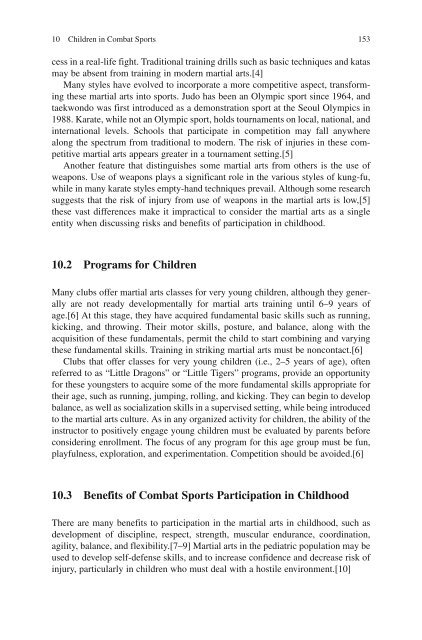Nutrition in Combat Sports
Nutrition in Combat Sports
Nutrition in Combat Sports
Create successful ePaper yourself
Turn your PDF publications into a flip-book with our unique Google optimized e-Paper software.
10 Children <strong>in</strong> <strong>Combat</strong> <strong>Sports</strong> 153<br />
cess <strong>in</strong> a real-life fight. Traditional tra<strong>in</strong><strong>in</strong>g drills such as basic techniques and katas<br />
may be absent from tra<strong>in</strong><strong>in</strong>g <strong>in</strong> modern martial arts. [4]<br />
Many styles have evolved to <strong>in</strong>corporate a more competitive aspect, transform<strong>in</strong>g<br />
these martial arts <strong>in</strong>to sports. Judo has been an Olympic sport s<strong>in</strong>ce 1964, and<br />
taekwondo was first <strong>in</strong>troduced as a demonstration sport at the Seoul Olympics <strong>in</strong><br />
1988. Karate, while not an Olympic sport, holds tournaments on local, national, and<br />
<strong>in</strong>ternational levels. Schools that participate <strong>in</strong> competition may fall anywhere<br />
along the spectrum from traditional to modern. The risk of <strong>in</strong>juries <strong>in</strong> these competitive<br />
martial arts appears greater <strong>in</strong> a tournament sett<strong>in</strong>g. [5]<br />
Another feature that dist<strong>in</strong>guishes some martial arts from others is the use of<br />
weapons. Use of weapons plays a significant role <strong>in</strong> the various styles of kung-fu,<br />
while <strong>in</strong> many karate styles empty-hand techniques prevail. Although some research<br />
suggests that the risk of <strong>in</strong>jury from use of weapons <strong>in</strong> the martial arts is low, [5]<br />
these vast differences make it impractical to consider the martial arts as a s<strong>in</strong>gle<br />
entity when discuss<strong>in</strong>g risks and benefits of participation <strong>in</strong> childhood.<br />
10.2 Programs for Children<br />
Many clubs offer martial arts classes for very young children, although they generally<br />
are not ready developmentally for martial arts tra<strong>in</strong><strong>in</strong>g until 6–9 years of<br />
age. [6] At this stage, they have acquired fundamental basic skills such as runn<strong>in</strong>g,<br />
kick<strong>in</strong>g, and throw<strong>in</strong>g. Their motor skills, posture, and balance, along with the<br />
acquisition of these fundamentals, permit the child to start comb<strong>in</strong><strong>in</strong>g and vary<strong>in</strong>g<br />
these fundamental skills. Tra<strong>in</strong><strong>in</strong>g <strong>in</strong> strik<strong>in</strong>g martial arts must be noncontact.[ 6]<br />
Clubs that offer classes for very young children (i.e., 2–5 years of age), often<br />
referred to as “Little Dragons” or “Little Tigers” programs, provide an opportunity<br />
for these youngsters to acquire some of the more fundamental skills appropriate for<br />
their age, such as runn<strong>in</strong>g, jump<strong>in</strong>g, roll<strong>in</strong>g, and kick<strong>in</strong>g. They can beg<strong>in</strong> to develop<br />
balance, as well as socialization skills <strong>in</strong> a supervised sett<strong>in</strong>g, while be<strong>in</strong>g <strong>in</strong>troduced<br />
to the martial arts culture. As <strong>in</strong> any organized activity for children, the ability of the<br />
<strong>in</strong>structor to positively engage young children must be evaluated by parents before<br />
consider<strong>in</strong>g enrollment. The focus of any program for this age group must be fun,<br />
playfulness, exploration, and experimentation. Competition should be avoided. [6]<br />
10.3 Benefits of <strong>Combat</strong> <strong>Sports</strong> Participation <strong>in</strong> Childhood<br />
There are many benefits to participation <strong>in</strong> the martial arts <strong>in</strong> childhood, such as<br />
development of discipl<strong>in</strong>e, respect, strength, muscular endurance, coord<strong>in</strong>ation,<br />
agility, balance, and flexibility. [7–9] Martial arts <strong>in</strong> the pediatric population may be<br />
used to develop self-defense skills, and to <strong>in</strong>crease confidence and decrease risk of<br />
<strong>in</strong>jury, particularly <strong>in</strong> children who must deal with a hostile environment. [10]

















